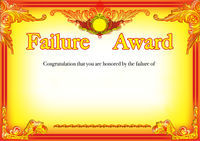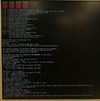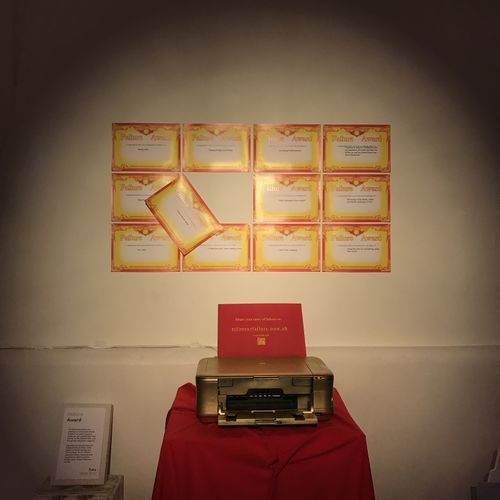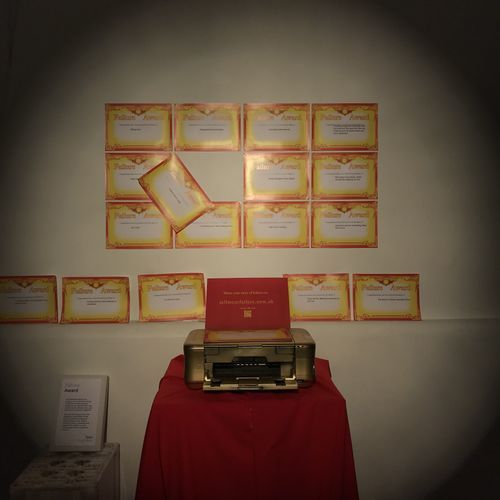Difference between revisions of "Failure Award"
| Line 74: | Line 74: | ||
| − | Two things that I appreciated the most. First, the comment I receiving during smoking time with Noemi and Emiel. They told me that they think my work is very subjective and direct, and they think I can go even further. Second, | + | Two things that I appreciated the most. First, the comment I receiving during smoking time with Noemi and Emiel. They told me that they think my work is very subjective and direct, and they think I can go even further. For so long, I tried my best to make works really 'me', but every time I focus on putting personal character something else will be missed. For instance, some projects I put too much attention on personality and ignored the communication to audience. |
| + | |||
| + | |||
| + | Second, the changed happen to audience about their opinion towards failure. I saw people were laughing in front of my device and discuss which award is more interesting. And the way classmates making jokes if our own projects fall, the people who don't pass can still get an award from my device. It made me feel very honoured that I offered another way of thinking such a negative and internal thing. | ||
Revision as of 17:21, 8 January 2019
Contents
Question & Inspiration
Failure has been a long time linked to humiliation and embarrassment in people’s mind. When it happens, it seems to be the end of the story and no-one wants to continue the discussion about it. I started to question these situations and analyse what failure is.
Failure as the opposite of success has rarely been treated as an individuality. In my opinion, success always contains luck. And success has very little chance to be reproduced in similar ways. Failure, however, contains logic and consequence, shows the way avoiding errors and provide experience that can be applied in other different cases.
Based on my concept about failure, I designed an interactive device. The device is consisted by a website and a printer. Audience can upload individual stories of failure to the website, the story will be sent to the printer and be printed out on an award paper.
The picture I used as award background comes from my own culture. In my school life back in China, every time before the school year officially ends, teachers come in to our classroom with a stack of award paper. Award for instance, the top 5 students gain the most credits, would be issued to certain students. It became extreme and generally became a standard of judging if the student is good or not. For students have no award it became humiliating.
I also had difficulties of facing this issue in that period. I thought it as vague reputation and an unfair way to judge students. But in the other way around, I can barely not to influenced by the atmosphere when most of my classmates are approved and fascinated by this system.
Process
I stated my research by reading the book Shailoh recommend to me, The Queer are of Failure. The book diversely provided me different ways of considering failure. It deconstructed failure, narrated the born of failure as a concept, how it was emphasised by culture and how it became the thought of mainstream in society. Generally, it inspired me to consider the idea of failure in different sense.
In the chapter three of The Queer Art of Failure, a series of photography called Fourth Place: The Art of Losing was mentioned. This series was taken by an Australian photographer named Tracey Moffatt. The main characters she captured in the photos are the athlete who got the fourth place in Olympic Games. She thinks the fourth place contains all unattractive elements o failure, it belongs to the winning side yet it is so close to winning that it made it humiliating.
No one can always win in competitions. On the other hand, everyone has once lost in real life. I people who once lost deserved an honour. So I decided to produced an interactive devices to issue failure award.
Scan Notebook
Experiment
Design of the device is very simple, audience in front of a printer will upload their own stories of failure in a certain way. The uploaded stories will be sent automatically to the printer and printed out. (The audience is allowed to take the award home and hang in an obvious wall. )
Apple Script
The first day I started, I succeed. I added a new rule to my email with the apple script I found online. With this rule, printer connected to MacBook can print out email with key words automatically. In this case, when audience send an email with title in failure, the printer will print out the story.
Raspberry Pi
Python
I gave up this way. Since my concept is about failure, I did not think it is reasonable for me to finish this project without any experience of falling. I started over again, worked with something I have never worked with before, the Raspberry Pi. I went through my one month journey of constant and diverse failures. As I said, failure provides logic, but logic does not guarantee success.
With suggestions, I started to try to use python on raspberry pi to read email first. I reinstalled the SD card and download the Raspbian Stretch Lite which only has basic operator interface. For the email, I chose gmail for try out. To login an email account, there are multiple ways, some needs two password, some needs to turn of certain options. Anyway I didn't get what I want. To distract my intension, I updated the system to Raspbian Stretch with desktop and recommended software which is a higher interface and looks like windows desktop.
Later, with right setting on google account python successfully read the information of receiving emails. I contacted my friend studies coding, he suggested me to start connecting raspberry pi and printer. He told me that printers have certification that's very hard to hack.
Google Cloud Print
Coding Gallery
Reflections
Out of my exception that audience enjoyed interacted with my device. I only prepared 60 printed paper for the installation at first, and I was even thinking there would must be some left overs. Some people said they like the concept and asked my plan to develop it. While some put their own award on the wall to join the demonstration.
Two things that I appreciated the most. First, the comment I receiving during smoking time with Noemi and Emiel. They told me that they think my work is very subjective and direct, and they think I can go even further. For so long, I tried my best to make works really 'me', but every time I focus on putting personal character something else will be missed. For instance, some projects I put too much attention on personality and ignored the communication to audience.
Second, the changed happen to audience about their opinion towards failure. I saw people were laughing in front of my device and discuss which award is more interesting. And the way classmates making jokes if our own projects fall, the people who don't pass can still get an award from my device. It made me feel very honoured that I offered another way of thinking such a negative and internal thing.
Conclusions
Media: Interaction Design
I chose interactive design as the media, because I see it as a way to trigger audience to reflect. Interaction design can create intense experience, hence I hope it can be my media to raise hidden questions.
Concept: Inertial Thinking
For a long time, I am interested in hidden message in inertial thinking. And I have been experimented it for a period as well. However, this is the most successful project along them all. This project shows me guidance of my own concept development and the way it blend with interaction.
Reference
Fail it! by Erik Kessels https://de.phaidon.com/store/general-non-fiction/failed-it-9780714871196/
The Queer Art of Failure by J. Jack Halberstam https://read.dukeupress.edu/books/book/1581/The-Queer-Art-of-Failure
Fourth by Tracey Moffatt https://www.artgallery.nsw.gov.au/collection/works/154.2011.17/
Error-The Art of Imperfection https://ars.electronica.art/error/de/































